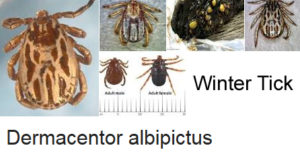Winter ticks are invading the Vermont moose population at higher rates than ever, wreaking havoc.
 Our neighbors to the north are facing a difficult decision about controlling the winter tick population and their effect on the Vermont moose population. In northern Vermont, Fish and Wildlife officials say that there is one moose per square mile. This higher moose population has drastically increased the population of winter ticks.
Our neighbors to the north are facing a difficult decision about controlling the winter tick population and their effect on the Vermont moose population. In northern Vermont, Fish and Wildlife officials say that there is one moose per square mile. This higher moose population has drastically increased the population of winter ticks.
About winter ticks – Dermacentor albipictus
 Winter ticks are not vectors for serious disease, but that doesn’t mean they are not deadly. Winter ticks hatch in the fall, and begin questing for their host. In Vermont, their main host is the moose. Once they attach for their blood meal, they remain on the host through the nymph and adult stages. As adults, they mate. The females drop the ground to lay their eggs at the end of winter, and then die. The issue is, the amount of ticks that are attaching to the moose population is enormous. Less than half of new moose calves are surviving, due to blood loss, and birth rates have fallen. One adult moose was found to host 9,000 winter ticks!
Winter ticks are not vectors for serious disease, but that doesn’t mean they are not deadly. Winter ticks hatch in the fall, and begin questing for their host. In Vermont, their main host is the moose. Once they attach for their blood meal, they remain on the host through the nymph and adult stages. As adults, they mate. The females drop the ground to lay their eggs at the end of winter, and then die. The issue is, the amount of ticks that are attaching to the moose population is enormous. Less than half of new moose calves are surviving, due to blood loss, and birth rates have fallen. One adult moose was found to host 9,000 winter ticks!
The solution to the winter tick overpopulation
Vermont wildlife officials have passed a 2020, any-sex moose hunt to eliminate 33 adult moose, thereby eliminating large hosts, on which winter ticks can thrive. It is believed that by decreasing the adult moose population, the winter tick life cycle will be halted for many ticks. The hunt will take place in October 2020. Nick Fortin, Vermont Fish and Wildlife biologist, says, “Without intervention to reduce the moose population, high tick loads will continue to impact the health of moose in that region for many years.”
Central Mass tick control

As always, in Central Massachusetts, choose at-home tick control for the health and happiness of your family.